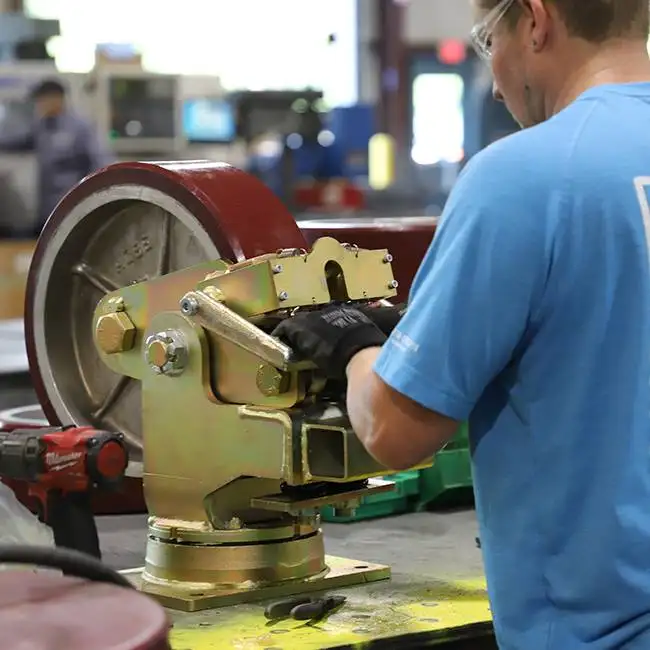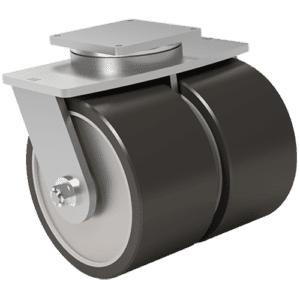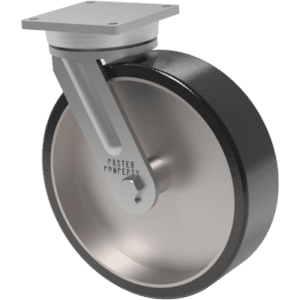Choosing between a Kingpin and a Kingpinless Swivel Caster depends on your application. Let’s review:
One of the many design variables when considering the best solution for your heavy duty industrial caster application is whether to include a kingpin vs. kingpinless swivel caster construction.
Kingpin Caster Construction:

99 Series Kingpin Dual Wheel Caster
Kingpin casters are an original and traditional caster design that has been used for a long time. They feature a design where a kingpin holds together two sets of bearings, one on top and one on the bottom.
A stem, typically a threaded bolt with a slotted nut or sometimes a rivet, is used to fasten the components of the swivel section to the top plate. The kingpin design utilizes a load bearing and thrust bearing to transmit the load.
Advantages:
- The kingpin allows for adjustment as the swivel section wears, which can extend the caster’s life.
- Tightening the kingpin nut creates resistance to the swivel motion, which is helpful when the caster is moving down an incline or at a high rate of speed (more than normal waking speeds).
- Control of flutter conditions. Flutter can occur when a swivel caster loses contact and orientation with the floor or ground, more common in higher speed applications or when the floor/ground surface is rough. When contact is made again, the caster may be in the right direction, causing a lurching motion of the caster and its load, possibly resulting in a major mishap or even injury.
- Silver Restrictors: You can use silver restrictors in kingpin casters for specific applications where you don’t want the wheel to spin freely. This is a useful feature when precise control is required.
- Thrust Bearings: Kingpin casters can accommodate thrust bearings. This is especially beneficial for applications with continuous use, such as automated systems, where the caster experiences frequent movement.
Disadvantages:
- Not Ideal for Impact Loading: Kingpin casters are not well-suited for applications that involve heavy impact loading. Impact loading occurs when a substantial force, such as a heavy load, is dropped onto or set onto the casters. This can lead to issues with durability and longevity, as the kingpin could become fatigued, distorted, or even sheared off. In this situation, thrust loads of the caster are transmitted through the kingpin, making it a vulnerable failure point for the caster.
- Kingpin-constructed casters are normally not used for higher loads, impact, and speed applications.
“Kingpinless” Caster Construction:

91 Series Kingpinless Caster
In the quest for the right kingpin vs. kingpinless caster, let’s look at the other side of the coin. While kingpin casters have their advantages, they may not be the best choice for applications with heavy impact loads or requiring minimal maintenance. This is where a kingpinless design offers a unique set of benefits. A kingpinless swivel section has fewer components, a top plate with a ball race, a yoke base (bottom race, and ball bearings.
Advantages:
- The kingpin is eliminated, and any failure associated with a kingpin is avoided.
- The caster load is spread over a larger area, allowing it to be used at higher speeds.
- The swivel motion is more uniform and swivels more easily.
- Less maintenance is required as there is no nut to be re-tightened.
Disadvantages:
Adjusting the swivel motion of the caster becomes much more difficult. Once the swivel raceways have worn, there is no way to adjust for this wear.
Kingpin vs. Kingpinless Swivel Casters Summary:
When deciding between a kingpin and a kingpinless swivel caster construction, both designs have their pros/cons. It is essential to fully understand the caster’s intended application, including loading conditions, speeds, duty cycles, floor/ground conditions, and other environmental concerns. When selecting your caster, we encourage you to contact our applications staff at customercentral@casterconcepts.com. You can also give us a call at 888-772-6790.



